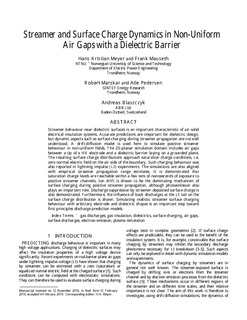Streamer and surface charge dynamics in non-uniform air gaps with a dielectric barrier
Journal article, Peer reviewed
Accepted version

Åpne
Permanent lenke
http://hdl.handle.net/11250/2637184Utgivelsesdato
2019Metadata
Vis full innførselSamlinger
- Institutt for elkraftteknikk [2500]
- Publikasjoner fra CRIStin - NTNU [38672]
Originalversjon
IEEE transactions on dielectrics and electrical insulation. 2019, 26 (4), . https://doi.org/10.1109/TDEI.2019.007929Sammendrag
Streamer behaviour near dielectric surfaces is an important characteristic of air-solid electrical insulation systems. Accurate predictions are important for dielectric design, but dynamic aspects such as surface charging during streamer propagation are not well understood. A drift-diffusion model is used here to simulate positive streamer behaviour in non-uniform fields. The 2D-planar simulation domain includes air gaps between a tip of a HV electrode and a dielectric barrier laying on a grounded plane. The resulting surface charge distributions approach saturation charge conditions, i.e. zero normal electric field on the air side of the boundary. Such charging behaviour was also reported in lightning impulse (LI) experiments. The simulations are also aligned with empirical streamer propagation range estimates. It is demonstrated that saturation charge levels are reachable within a few tens of nanoseconds of exposure to positive streamer channels. Ion drift is shown to be the dominating mechanism of surface charging during positive streamer propagation, although photoemission also plays an important role. Discharge suppression by streamer-deposited surface charge is also demonstrated. Furthermore, the influence of back discharges at the LI tail on the surface charge distribution is shown. Simulating realistic streamer surface charging behaviour with arbitrary electrode and dielectric shapes is an important step toward first principles discharge prediction models.